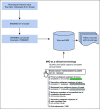Design and Evaluation of a Computational Phenotype to Identify Patients With Metastatic Breast Cancer Within the Electronic Health Record
- PMID: 36179272
- PMCID: PMC9848550
- DOI: 10.1200/CCI.22.00056
Design and Evaluation of a Computational Phenotype to Identify Patients With Metastatic Breast Cancer Within the Electronic Health Record
Abstract
Purpose: Outcomes for patients with metastatic breast cancer (MBC) are continually improving as more effective treatments become available. Granular data sets of this unique population are lacking, and the standard method for data collection relies largely on chart review. Therefore, using electronic health records (EHR) collected at a tertiary hospital system, we developed and evaluated a computational phenotype designed to identify all patients with MBC, and we compared the effectiveness of this algorithm against the gold standard, clinical chart review.
Methods: A cohort of patients with breast cancer were identified according to International Classification of Diseases codes, the institutional tumor registry, and SNOMED codes. Chart review was performed to determine whether distant metastases had occurred. We developed a computational phenotype, on the basis of SNOMED concept IDs, which was applied to the EHR to identify patients with MBC. Contingency tables were used to aggregate and compare results.
Results: A total of 1,741 patients with breast cancer were identified using data from International Classification of Diseases codes, the tumor registry, and/or SNOMED concept identifiers. Chart review of all patients classified each patient as having MBC (n = 416; 23.9%) versus not (n = 1,325; 75.9%). The final computational phenotype successfully classified 1,646 patients (95% accuracy; 82% sensitivity; 99% specificity).
Conclusion: Hospital systems with robust EHRs and reliable mapping to SNOMED have the ability to use standard codes to derive computational phenotypes. These algorithms perform reasonably well and have the added ability to be run at disparate health care facilities. Better tooling to navigate the polyhierarchical structure of SNOMED ontology could yield better-performing computational phenotypes.
Conflict of interest statement
Figures


References
-
- Kennecke H, Yerushalmi R, Woods R, et al. : Metastatic behavior of breast cancer subtypes. J Clin Oncol 28:3271-3277, 2010 - PubMed
-
- Tao L, Chu L, Wang LI, et al. : Occurrence and outcome of de novo metastatic breast cancer by subtype in a large, diverse population. Cancer Causes Control 27:1127-1138, 2016 - PubMed
Publication types
MeSH terms
Grants and funding
LinkOut - more resources
Full Text Sources
Medical

